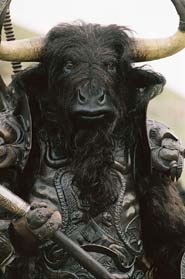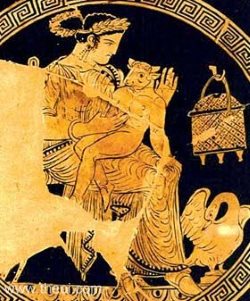
If ever you are stuck for ideas, look to Greece.
In the ancient myths and legends of Greece, there are intriguing prophecies, clever generals, jealous deities, inventive punishments – and frightening beasties. Herodotus is a favourite of mine for such tales, but there’s plenty to draw from. The plays of Euripides and Sophocles, or for a more comedic bent, Aristophanes. The histories of Thucydides and Xenophon, the biographies of Plutarch.
But the best source for today’s topic is Apollodorus and his Library of Greek Mythology, in which is told the story of the Minotaur.
The Minotaur in Myth
The Minotaur is a fantastic and very Greek monster: half-man, half-bull, fierce and immensely strong. It feasts on human flesh and lurks within a maze – a maze which is as much a trap for its victims as it is for the beast itself. Dangerous, sinister and uniquely unnatural. No wonder the myth was relished by storytellers from across the ages.
But I’m getting ahead of myself. What is the minotaur, and where did it come from?
Impiety was the worst crime a Greek hero or king could commit. The gods were jealous and powerful beings, and if they saw that you were not giving them due deference, they could be, shall we say, imaginative with their vengeance. Such is the case with the minotaur.
The story starts with the king of Crete, Asterios. He did not have sons, and so when he died there was no successor to take over. There were many men who wanted to be king, and one of them was Minos. In attempt to secure his claim, Minos told people that the gods had granted him the kingdom; as proof, he claimed that whatever he prayed for, he would receive. He prayed to Poseidon, the god of the sea, the earthshaker, for a bull, which he promised he would then sacrifice to Poseidon. And so a magnificent white bull walked out of the waves, and Minos was made king – and he sent the white bull to his paddocks, and took another bull and sacrificed that instead.
Poseidon, as you can imagine, wasn’t too thrilled by this. Minos had broken his word, and so his punishment would come via the bull he had sworn to sacrifice. Poseidon made the bull a fierce and untameable thing, and he made Minos’s wife, Pasiphae, fall in love with it. Poseidon gave her a deep passion, an unending lust for this bull. Pasiphae enlisted the help of a craftsman and inventor, Daedalus, to help her have sex with the bull. Daedalus made a wooden cow, a hollow thing wearing the skin of a real cow, and wheeled it out to the field where the bull pastured and had Pasiphae climb inside it. The bull mated with the wooden cow with Pasiphae inside as if it were a real cow. And the result was that, shortly afterward, Pasiphae gave birth to the Minotaur, who was a creature with a human body but the head of a bull.

Once the Minotaur was weaned, it became fierce and developed a taste for human flesh. Minos consulted with oracles and employed Daedalus to build a maze, the Labyrinth, to imprison the Minotaur. Sacrifices had to be made, though – people sent in to their deaths. After Minos won a war against Athens, he demanded that seven young men and seven maidens of Athens be sent annually to be fed to the Minotaur.
The third year this happened, the prince of Athens, Theseus, was included in the tribute – or volunteered to go, promising his father, King Aegeus, to change the ship’s black sail to a white one if he returned alive. Theseus went, and when he arrived at Crete he met Ariadne, the daughter of Minos, who promised to help him kill the Minotaur if he would marry her and take her back to Athens. When Theseus agreed, Ariadne spoke to Daedalus and he told her that if Theseus had a thread tied to the door of the Labyrinth to lead him back, he would find his way out by following it.
So in Theseus went, in through the winding path of the Labyrinth, playing out the thread behind him. At last he found the Minotaur and the boys and girls sent as tribute, and here is the time to quote from the text:
He killed it with blows from his fists.
(Apollodorus, The Library of Greek Mythology, Epitome 1.)
Theseus beat the Minotaur to death with his bare hands. He was a pretty impressive guy, after all, his previous feat having been to kill a rampaging bull (that may well have been the white bull that fathered the Minotaur, depending on which version you go by). And he returned to Ariadne, but the god Dionysus fell in love with her and took her away for himself, so Theseus, grieving for the loss of Ariadne, forgot to change the sail. King Aegeus saw the black-sailed ship returning to Athens and, believing his son dead, threw himself into the sea, which has since then been known as the Aegean Sea.
And that is it: the Minotaur, from impious beginnings to its final boxing lesson at the hands of Theseus. A frightening creature that must be imprisoned in a maze, and could only be defeated by a hero, a prince from Athens.
The Minotaur in Literature and Modern Fantasy
The story of the Minotaur was never forgotten, but it wasn’t just in modern stories that it has been reused. Dante’s Inferno contains mention of the Minotaur, where Dante and Virgil encounter it guarding the entrance to the Seventh Circle of hell, the circle of violence. The Minotaur is here seen as representing all three rings of the circle: violence against others, for he ate people; violence against oneself, whereby in Dante’s version the Minotaur is seen as biting itself; and violence against nature, for what could be more unnatural than the product of a human mating with an animal?
More recently, CS Lewis used the Minotaur not as a single individual but a whole species, aligned with the White Witch and thereby retaining the evilness of their origins, albeit without the myth behind it. And from there, minotaurs became a fantasy race, used as monsters to battle in Dungeons & Dragons and various games stemming from it. In World of Warcraft the Minotaur’s appearance has inspired the Tauren race, but their temperament is quite a contrast to the angry, flesh-eating Minotaur of the Greek myth.
The Minotaur has been reimagined in other ways too. In the slightly bizarre fantasy webcomic Gunnerkrigg Court by Tom Siddell, there is a minotaur called Basil, who lives peacefully in a labyrinth hidden behind a secret door in the library of the Court. Basil gives his version of events in which Theseus is a drunk, party-crashing jerk.
Your Minotaur
The Minotaur at its roots was a dark and unnatural creature, a punishment for impiety, a representation of pure violence. It has been reused as a powerful and frightening fantasy race (though don’t ask me how they reproduce; I’ve never heard of a female minotaur). It has also been reinterpreted as a peaceful fellow whose story has been twisted by a rival to paint him as evil.
Which path would you pick? How would you use the Minotaur?
Also, what is your favorite depiction of the Minotaur in literature or film? What makes this depiction stand out?
For articles on fantasy, ancient history, and writing fiction, visit Alice Leiper’s website, Ally’s Desk.


Well,,this is my depiction of the Minotaur
http://www.kraxon.com/the-twelve-the-bull/
Never expected the mighty Minotaur to have such a disheartening ending. When Riddler set up Batman and Robin in a minotaur maze and minotaur boss, it kind of intrigued me how the minotaur came to be imprisoned and to be featured. Theseus won with brawns, though Batman triumphed with his brain.
Well, I didn’t know a lot about Minotaurs before this. Now I know too much – excuse me while I recover from the description of how the Minotaur was conceived. I suspect that at heart Minotaur was really a marshmallow. Some evil jealous rival made up a twisted rumor about how many people Minotaur had eaten and due to the creature’s unfortunate appearance, everyone believed it. I see the Minotaur as a sort of beauty and the beast type character. Disney should make a movie about him.
Yes, the Minotaur and maze story has always fascinated me. In fact, one of my favourite singer/songwriters wrote a song called Minotaur and Maze. It’s very good inspiration for all art and literature.
Its a great monster. I’m always after the rarer fantasy creatures. I love the old myths of the minotaur. Great post.
I have to admit, I’d never heard of the Minotaur until the creature was incorporated into the last season of “American Horror Story”. It’s a very interesting concept with a lot of potential.
I created several unique cultures centered on Greek Mythos, including the Minotaur and the Centaur. They both have their own cultures and generally war against one another.
Thank you very much for this post. Its always good to remember where things come from.
There are lots of great creatures from myths to choose from – the minotaur being one of the best. Thanks for sharing it!
This post is right up my alley! I retell Greek myths and medieval legends in my series The Labors of Ki’shto’ba Huge-Head(set in my alien termite culture), but I didn’t use the Minotaur because my Greek myths mainly involve Hercules. I would love to reblog this article on my termitespeaker blog sometime, since one of my themes for that blog is how myth is retold in literature. Do I need permission?
Hi Lorinda, I’m glad you enjoyed the article. I’d rather it if you quoted the most relevant parts of the article and linked to it here. But I love the idea of Hercules retold with termites. I can see how termites can manage the Augean stables labour, but I worry a termite trying to get mystical apples might get distracted in the mystical apple tree trunk.
I’ll just keep this article in mind for a later post, and I would certainly credit the source. My extraterrestrial termites average a meter in length. Actually, I didn’t use the Augean stables at all, and the Golden Apples become the Golden Fungus even as the Quest for the Golden Fleece becomes the Quest for the Golden Fungus.
I’ve got to say, the minotaur in the labyrinth in Your Highness was rather memorable.
It’s “encounter” with Danny McBride was disturbing – yet laugh out loud funny.